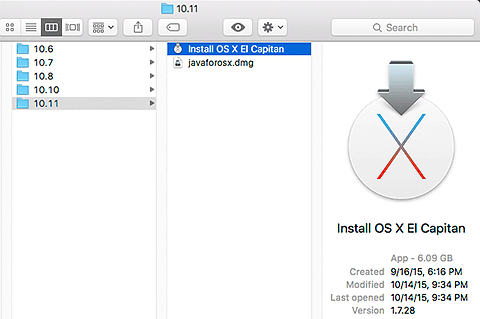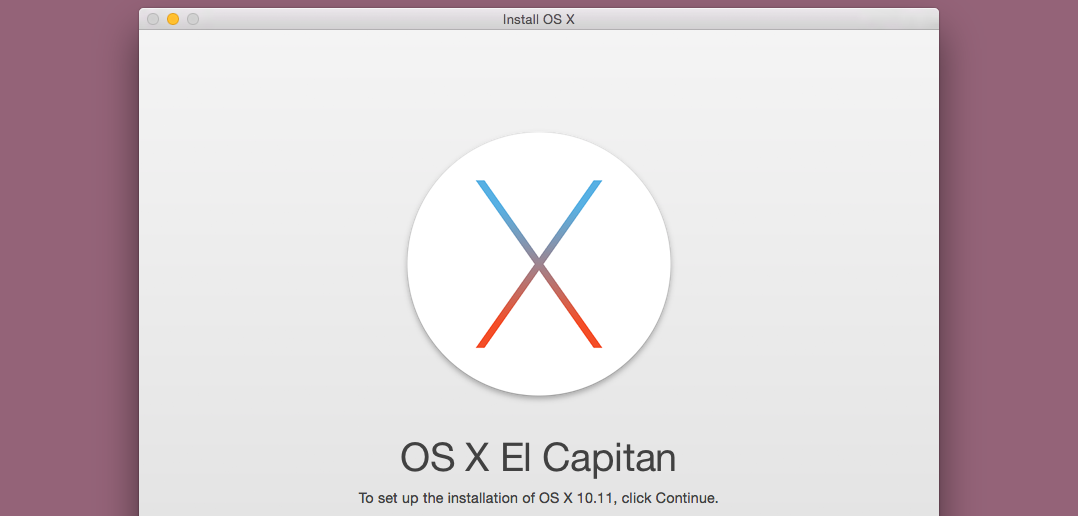Install 10.11
- Install 10.11 On Mac
- 10.11 Install From Usb
- Install 10.11.4
- How To Install 10.11 On Mac
- Install 10.11 On Vmware
How to Install DirectX 9,10,11,12 Runtimes in Windows 10 100% Working Method (2021) In this video, I'll show you how to install Microsoft Direct. ARCHIVED: Install or upgrade OS X 10.11 (El Capitan) This content has been archived, and is no longer maintained by Indiana University. Information here may no longer be accurate, and links may no longer be available or reliable.
Hi charanjeet16,

I would first check to to see if your Mac is compatible to upgrade the the latest version of MacOS.
One thing to note about MacOS Catalina is that it drops support for 32-bit applications.
If you still use 32 bit applications you could upgrade to MacOS Mojave, 10.14 if your Mac supports it. It still supports 32 bit apps and is the last operating system before MacOS Catalina, 10.15.
If you go to About this Mac under the Apple Menu, and provide the year and what Mac you have, I can help you find what operating system your Mac can support if needed.
I hope this helps.
Oct 30, 2019 12:13 PM
Case: Can I reinstall Windows without losing files?
How does reinstalling Windows 10 work, will it erase your data?
When you've tried many solutions to fix system errors and none of them actually works, it may be the time to clean install Windows 10 and get all problems sorted out. But does this process delete your important data? Can you reinstall Windows 10 without any data loss?
Well, it depends on the approach you take:
By using Repair Install, you can choose to install Windows 10 while keeping all personal files, apps and settings, keeping personal files only, or keeping nothing.
By using Reset This PC, you can do a fresh install to reset Windows 10 and keep personal files, or remove everything.
By using installation disk to perform a clean install, your data won't be delete, but will be moved to Windows.old folder in the root directory of C: drive after installing.
In short, you definitely can, and have different methods to reinstall Windows 10 without losing data.
If you are pretty sure that all your files and applications are in good conditions and have no thing to do with the problem you are facing, then you can choose a way to reinstall Windows 10 without losing files and programs.
To do that, Windows will scan your C: drive and place all your personal data aside. And when the installation is complete, Windows will put these files and settings back.
If you are using a genuine Windows 10, Windows 10 will automatically get activated after the reinstallation.
Quick navigation for Windows 10/11 reinstallation:
Method 1: Repair install Windows 10/11 without losing any data
If your Windows 10 can boot and you believe all the installed programs are fine, then you can use this method to reinstall Windows 10 without losing files and programs. If one or more of your program are damaged, you'd better keep personal files only.
1. Download Windows Media Creation tool from microsoft.com and create an installation ISO file with it.
2. Double click to mount the ISO file (for Windows 7, you need to use other tools to mount it). At the root directory, double-click to run the Setup.exe file.
3. When the Windows 10 Setup is ready, you can whether to download updates or not based on your needs.
4. In the What needs your attention screen, click 'Change what to keep' option.
5. Then, you will access the Choose What to keep screen, you have three options, namely, 'Keep personal files, apps, and Windows settings', 'Keep personal files only', or 'Nothing'. Choose the first option and click Next.
6. Here you will go back the What needs your attention screen, confirm the option you select and click Refresh.
This may take a while because it will spend extra time scanning your hard drive and moving files. If you just want to keep your files where they are, then try the next method.
Method 2: Fresh install Windows 10/11 without losing personal files
Windows 10 provides the feature 'Reset this PC' to help you solve system problems by resetting your computer to factory settings. During the process, you can choose whether to keep your personal files or not.
1. Open Reset this PC from computer or boot.
>> If it's a working computer and still bootable, please go to Settings >Update & Security >Recovery >Reset this PC and select Get Started under Reset this PC option.
>> If not, you can create a recovery drive and then boot from it, then choose language and other preference and click Next >Repair your computer >Troubleshoot >Reset this PC.
2. After selecting Reset this PC, your have two options, 'Keep my files' and 'Remove everything', select the first option. It will remove apps and settings but keep your personal files where they are.
3. Then, in the Ready to reset this PC window, it will tell you all the changes during the process. Confirm it and click Reset.
You can also reset Windows 10 from command line. The process are shown below:
1. Type “cmd” in the search box and press Enter.
2. In the listed results, right click on the Command Prompt and select 'Run as Administrator'.
3. Type “systemreset” (without quotes) in the command prompt window and press Enter. If you need to install Windows 10 and new updates, you can run command “systemreset -cleanpc”.
Method 3: Clean install Windows 10/11 without losing data
If you prefer installing Windows 10 without losing data from USB drive or installation disc, you can choose to upgrade Windows 10 using this method. Before you do, you need to make sure your C: drive has more than 16GB of free space.
1. Insert your installation disc and boot from it. If you do not have one, you can download the Windows Media Creation tool to create one.
2. When it loads, select the language and keyboard, then click 'Next'.
3. Click 'Install Now'.
4. Type your product key or skip it. Usually, your computer will be activated automatically when it's connected to a network if your install the same version of Windows 10 as before.

5. Select the installation type 'Custom'.
6. At the following screen, just select the C: drive and click Next to proceed. Then, wait patiently until the installation complete 100%.
As long as you do not format the C: drive in the Setup, you will not lose your data, but they are moved to another location. After the installation, you can find a folder Windows.old in the root directory of C: drive. All your files are saved there.
After copy all your needed files out from Windows.old folder, you can use Disk Cleanup to delete the Windows.old folder to free up disk space.

Reinstalling Windows 10/11 isn't always a perfect solution
Though there are several methods to choose, they all have some shortcomings in practical use. For example, the first method will keep your programs, but won't fix problems caused by them. And the other two methods can only keep your files, so you have to spend time and effort reinstalling these apps. That's why I say reinstallation is not a perfect way.
To avoid such trouble, you can use a free backup software to create a system image in case of possible system issues. For simplicity and effectiveness, I strongly recommend you AOMEI Backupper Standard to protect your Windows 10/11 PC.
- It enables you to backup file, partition, system or even the whole disk in a simple manner.
- It can save you from manual operation with the scheduled backup on daily, weekly, monthly, etc.
- With the incremental/differential backup mode, it will only backup changed files instead of all files, which greatly reduces the risk of the backup disk full issues.
- You can change the compression level, split backup images, use Microsoft VSS service and intelligent sector backup as you like.
Download this software to create a backup image right now with the following steps.
Backup Windows 10/11 to protect everything on it
Install 10.11 On Mac
If you want to recover your computer easily and quickly without losing stored personal data and installed apps, you could consider creating a system image backup in Windows 10/11 with free backup software.
Note a single backup will only backup the items in the system partition when you create it, and changes made later will not be included. Thus, if you don't want to lose any important data, it's suggested to create a schedule automatic backup in Windows 10/11.
Then, let's get the detailed steps.
1. Launch this free backup software, click the 'Backup' tab on the main page, and then choose 'System Backup'.
Note: If you want to backup entire disk, you can choose 'Disk Backup' as instead.
2. Select a destination location to receive the backup image. You can backup to any location (folder) that Windows detects, including external hard drive, NAS network location, local storage, etc.
10.11 Install From Usb
3. In the next screen, click 'Schedule' to configure scheduled backup settings if needed. After that, click 'Start Backup' to start the operation.
Note: System backup in AOMEI Backupper Standard can satisfy almost users' need. But if you have advanced needs like below, higher editions like Professional may serve you better.
• Enable encryption for backup: This feature is useful for users who store sensitive data or business data on their computer to prevent unauthorized access.
• USB Plug in: This feature is designed for users who frequently use USB storage device, and make the backup task more convenient. Once you create a schedule backup with 'USB Plug in', AOMEI Backupper will automatically start backup when USB connected to your computer.
• Scheme: This is an indispensable feature for all users who don't want to miss any changes, but worry about disk space issue. It can delete old backups automatically when backup versions reach the specified number.
In a short time, the backup will be created. With a backup, whenever you have problems with your system, you can easily restore from the backup. Even when your PC fails to boot, you can restore from bootable CD. AOMEI Backupper also enables you to create a specialized recovery environment for backup/restore without booting Windows. Just go to Tools >Recovery Environment to enable it.
Install 10.11.4
Wrapping things up
To reinstall Windows 10 without losing data is surely possibly using these three methods mentioned above, and it can fix system issues that your computer may have. But, honestly, it's not perfect. And it is obvious that restoring from a backup is easier and more convenient to solve Windows issues.
How To Install 10.11 On Mac
The basic version AOMEI Backupper Standard is enough to prevent unexpected disaster, such as, system crash, disk failure, virus, fire etc. But if you want more advanced features, such as, USB plug in, incremental and differential backup, universal restore, you need to upgrade from the basic version.
Install 10.11 On Vmware
If you want to protect unlimited computers within your company, AOMEI Backupper Technician is worth a shot. The inbuilt AOMEI Image Deploy tool allows users to deploy/restore system image file on a server-side computer to multiple client-side computers over the network. What's more, you are able to create portable AOMEI Backupper that can run from a removable device on any computer.